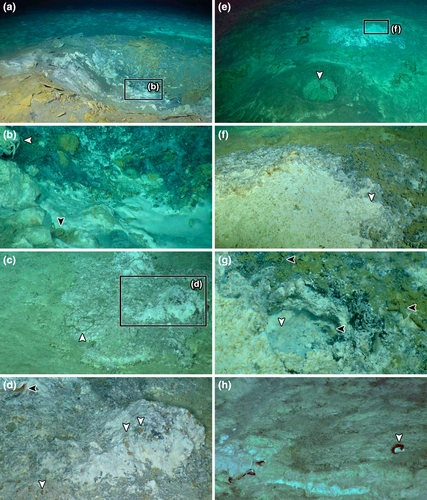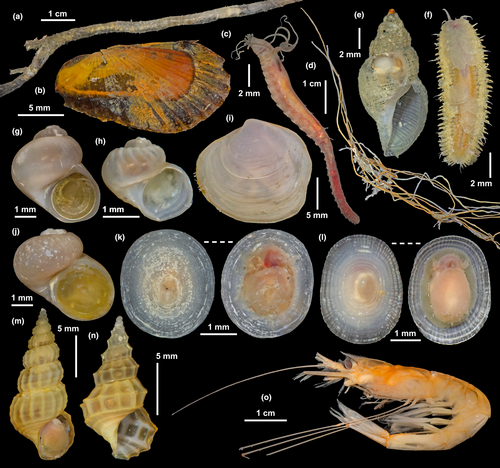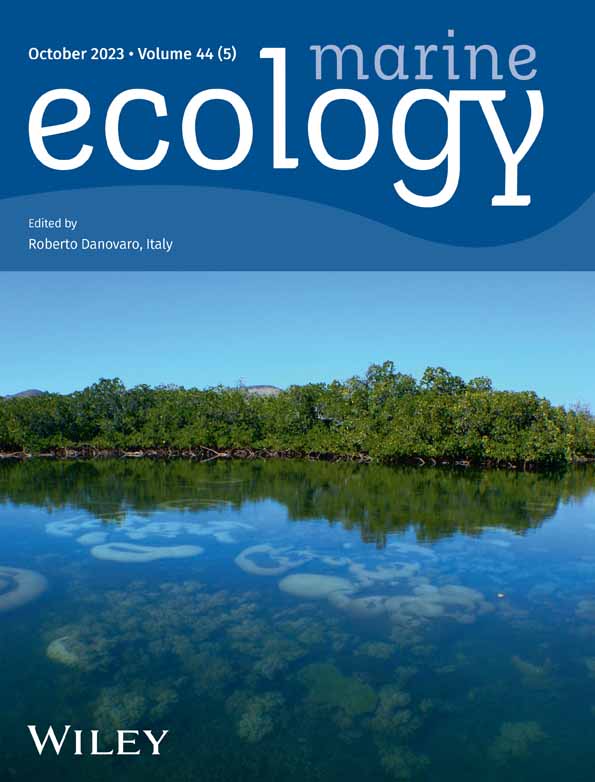Unexpected discovery of a serpentinite-hosted chemosynthetic ecosystem on Asùt Tesoru Seamount, Mariana Forearc
Abstract
Chemosynthetic ecosystems powered by microbial primary production are rare ‘hot spots’ of biological activity in the deep-sea characterized by dense aggregations of specially adapted animal species. Among settings where such systems have been found, serpentinite-hosted seep systems supported by alkaline geofluid are particularly understudied with just a few known sites worldwide. Mariana Forearc hosts the world's only series of active serpentinite mud volcanoes, but seep communities have only been reported from South Chamorro Seamount where large bathymodioline mussels dominate. Here, we report the discovery of a serpentinite-hosted seep on the conical summit of Asùt Tesoru Seamount, Mariana Forearc. Named the ‘Big Blue Seep’, this field features white, likely carbonate crusts inhabited by animals, under which fluid seepage could be seen. We confirm 16 animal species, including typical seep-associated fauna such as Desbruyeresia gastropods and Acharax awning-clams. This is surprising as previous research expeditions did not notice any sign of chemosynthesis-based ecosystems on this seamount, although the community is indeed difficult to spot due to the lack of large-bodied epifauna such as mussels. The Big Blue Seep is adjacent to three drill holes made by the International Ocean Discovery Program expedition 366 (Holes U1496A-C), which may have impact on seepage. Our findings represent the second chemosynthesis-based ecosystem associated with serpentinite mud volcanism, suggestive of further such communities on other Mariana Forearc mud volcanoes.
1 INTRODUCTION
The Mariana Forearc is home to the only known series of active serpentinite mud volcanoes on Earth, formed by mantle-sourced serpentinite mud exuded as a result of the Pacific Plate's subduction (Fryer et al., 2006; Hulme et al., 2010; Wheat et al., 2010). These seamounts continue to seep low-temperature, alkaline-reducing geofluids rich in methane, sulfate, and hydrogen gas, theorized to support the world's most alkaline subsurface microbial communities (Takai et al., 2005; Wheat et al., 2008). Furthermore, the discovery of the 5700 m deep Shinkai Seep Field (SSF) facing the Challenger Deep with dense vesicomyid clam colonies confirmed that serpentinite-hosted seeps can support lush chemosynthesis-based communities (Ohara et al., 2012; Okumura et al., 2016), much like those famously known from hydrothermal vents (Corliss et al., 1979; Levin, 2005). Despite this, South Chamorro Seamount (13°7′ N, 146°00′ E, located about 125 km east of Guam) has been the sole serpentinite mud volcano with a seep ecosystem (Fryer & Mottl, 1997), even when many others have been explored by submersibles and coring (Fryer et al., 2018; Hulme et al., 2010). The seep community on South Chamorro Seamount is dominated by bathymodioline mussels, though ‘tubeworms', squat lobsters, and snails in genera Desbruyeresia and Phymorhynchus have also been reported (Chen et al., 2016; Fryer & Mottl, 1997).
Asùt Tesoru Seamount (18°00′–18°20′ N, 147°00′–147°20′ E) is the largest serpentinite mud volcano on the Mariana Forearc with a diameter of about 40 km, rising 2.4 km from the base (Oakley et al., 2007). It is known informally as Big Blue Seamount, due to the blue serpentinite mud characteristic of its sediment. Fluids up to pH 12.5 under slab conditions have been confirmed from the southwestern conical summit with three circular mounds by gravity and piston coring (Mottl et al., 2004), concentrated on the largest mound about 350 m in diameter. In January 2017, scientific drilling by the International Ocean Discovery Program (IODP) drilled three holes here (Figure 1a; Holes U1496A, 40.8 mbsf; U1496B, 36.0 mbsf; and U1496C, 105.0 mbsf) (Eickenbusch et al., 2019; Fryer et al., 2018). Though visual explorations with subsea camera and also remotely operated vehicle (ROV) have been conducted, there has been no report of either fluid springs as evidenced by carbonate or brucite structures, nor the presence of geofluid-associated ecosystems (Fryer et al., 2018; Hulme et al., 2010). Here, we present results from a recent ROV survey, the first to confirm the presence of a chemosynthesis-based community on this seamount concentrated around white carbonate-like crusts.

2 MATERIALS AND METHODS
We surveyed the conical summit of Asùt Tesoru on two dives of the ROV KM-ROV on-board R/V KAIMEI cruise KM23-05 in March 2023 (for tracks see Figure 1b). During the ROV dives, high definition (1920 by 1080 pixels) video was recorded using a Mini Zeus video camera; frame grabs were taken for sea-floor imagery as the KM-ROV lacked a still camera. The KM-ROV carried a conductivity, temperature, and depth sensor (Seabird SBE-49 Fast CAT), which recorded temperature data at one-second intervals. These dives were conducted based on bathymetry obtained using a Konsberg EM112 multibeam echosounder equipped on R/V KAIMEI, postprocessed using Generic Mapping Tools (GMT) to produce the final maps (Wessel et al., 2019).
Animal samples were collected either using a suction sampler, or directly taken by the manipulator into a sample box using a scoop sampler. Immediately after recovery on-board the research vessel, the animals were moved into a cold room set at 4°C. Then, they were washed on a 1 mm sieve, followed by sorting into morphotypes both by eye and under a dissecting microscope (Olympus SZX9). Representative specimens were selected for macrophotography using a Canon EOS 5Ds R camera system with the EF 100 mm F2.8L MACRO IS USM macro lens. Specimens were preserved in either 99% ethanol, 10% buffered formalin, or directly placed in a deep freezer set to −80°C.
3 RESULTS AND DISCUSSION
On the conical summit of Asùt Tesoru (water temperature 3.3–3.4°C), we encountered several patches up to 3 m across, where whitish crusts most likely comprising carbonates (Oakley et al., 2007) had developed (Figure 2). These were located at a diameter of approximately 80 m between the IODP Holes U1496A and U1496B (Figure 1), and majority of the active patches were adjacent to either Holes U1496A or U1496B. These two holes were untreated, whereas U1496C was capped with a casing pipe and re-entry cone (Fryer et al., 2018). One patch of carbonate-like crust (18°06.6251′ N 147°06.1076′ E, 1240 m deep) was found directly above Hole U1496B, which has been filled in or crusted over (Figure 2a,b; 18°06.5957′ N 147°06.1028′ E, 1243 m deep), the central part appeared to be slowly seeping out white, smoky geofluid. The largest patch was found next to Hole U1496A (Figure 2e), and unlike the one near U1496B, fluid seepage was not originally evident at the U1496A patch. Nevertheless, whitish fluid exuded when a piece of crust was broken (Figure 2f,g), though we cannot completely exclude the possibility that this was from the resuspension of crust material. The crusts differed in stiffness, with more brittle ones being dominated by worm tubes of the annelids Amphisamytha and Sclerolinum (Figure 2b,g) and solid ones by dense aggregations of the abyssochrysoid snail Desbruyeresia (Figure 2c,d). These are fauna typical of vent and seep habitats (Chen et al., 2016; Xu et al., 2022; Zhou et al., 2019) and indicate active seepage in this area supporting a chemosynthetic ecosystem—which we name the ‘Big Blue Seep’ (BBS). This discovery is unexpected because previous expeditions did not notice any sign of chemosynthesis-based fauna (Fryer et al., 2018; Hulme et al., 2010). As crusts were not available for the present study, future studies of these materials are needed to confirm its carbonate nature and reveal more information on the nature of the seep fluid.

We collected 15 animal species inhabiting the carbonate-crusted patches, including four annelids, two bivalves, seven gastropods, and one shrimp (see Figure 3 and captions for the list). We also sighted a Munidopsis squat lobster (Figure 2b), making the total species count of 16. Among these, the limpet Bathyacmaea (Figure 3l) has also been found in South Chamorro (Sato et al., 2020) and the abyssochrysoid snail genus Desbruyeresia is common at both South Chamorro and the BBS (Chen et al., 2016), though the two Desbruyeresia species here (Figure 3m,n) are not shared with South Chamorro and appear to be undescribed. The only genus shared with the SSF is the parchment worm Phyllochaetopterus (Watanabe et al., 2021). The three trochoid-shaped snails are unique to the BBS among all known seeps. Until now, Iheyaspira exhibited a curious disjunct distribution in the Okinawa Trough and Caribbean Sea (both vents) and its presence in the Mariana Forearc indicates a wider distribution (Nye et al., 2013). Dillwynella has only been found on wood and algal organic falls (Kunze, 2011), and our finding of a likely new species at the BBS is the first record of this genus in seeps. The neomphalid snail is morphologically most similar to an undescribed species collected from an alluded seep in the Kuril–Kamchatka Trench (Fukumori et al., 2019); these potentially represent undescribed genus or genera. Taken together, our results indicate a limited similarity in faunal composition between the BBS and other known chemosynthetic ecosystems in the Mariana region (Giguère & Tunnicliffe, 2021; Okumura et al., 2016).

The three BBS species in genera with known chemosymbiosis, including the bivalves Thyasira and Acharax as well as the tubeworm Sclerolinum, are in clades forming obligatory relationships with sulfur-oxidizing bacteria (Xu et al., 2022). Though geofluids at serpentinite mud volcanoes do not contain sulfide as the initial components when generated in the deep plate boundary zones, they contain high concentrations of methane, hydrogen gas, and sulfate which could lead to sulfate reduction via either microbial anaerobic methane–oxidation (Wheat et al., 2020) or hydrogen–oxidation (Kawagucci et al., 2018) to produce sulfide during upwelling. This source of sulfide likely fuels chemosynthesis in symbioses at the BBS. The two generally carnivorous animals, including the conoid snail Daphnella and the shrimp Nematocarcinus (Cartes, 1993), are not typically associated with seeps and instead are likely peripheral taxa invading the seep to exploit food sources available there (Levin, 2005).
Unlike the community at South Chamorro Seamount dominated by bathymodioline mussels (Fryer & Mottl, 1997) or the SSF with vesicomyid clam fields (Ohara et al., 2012), no large-sized epibenthic fauna were seen at the BBS which makes the seep community much more obscure and perhaps explains why it remained undiscovered. Our discovery of the BBS, a visually humble but nevertheless species-rich chemosynthetic ecosystem with unique faunal composition on Asùt Tesoru, indicates such systems may also exist at other active serpentinite mud volcanoes on the Mariana Forearc—like Conical Seamount where unidentified limpets and snails have been seen (Fryer, 1990)—warranting future expeditions.
The close proximity between the carbonate-like crusts and the Holes U1496A and U1496B, especially the patch immediately on U1496B (Figure 2a,b), is suggestive that the current seepage may be linked to scientific drilling. As the whitish, fluffy sediment surrounding most of the carbonate-crusted patches is almost certainly drill cuttings (and mud) (Fryer et al., 2018), the crusts must have formed after the drillings in January 2017 and therefore likely less than 5 years old. The biological community probably newly colonized or re-established after drilling. As there are no published sea-floor images before drilling, it is unclear whether similar seepage sites were present already in the area before and then buried—as was seen in a vent community at the Okinawa Trough after scientific drilling (Kawagucci et al., 2013; Nakajima et al., 2015)—or if the drilling led to novel fluid discharges that activated the BBS. Although predrilling video surveys and ROV dives have previously been conducted on this seamount (Fryer et al., 2018; Hulme et al., 2010), these videos and dive tracks are unpublished and not readily available for comparison. Either way, the IODP drillings certainly altered the faunal community at Asùt Tesoru, something to keep in mind for future operations. Currently, the IODP does have an Environmental Protection and Safety Panel, which reviews proposals from both safety and environmental protection aspects (IODP, 2023) but there is no set regulation against drilling on biological assemblages. Furthermore, visual inspection of the drilling target area is conducted with a video camera attached to the drill in many cases (only rarely with ROVs), with insufficient resolution and attention to observe small-scale seep communities like the BBS. We recommend the IODP to always take into consideration the conservation of known unique sea-floor assemblages when making decisions on drilling target points, and also conduct more detailed predrilling surveys prior to drilling expeditions—the tracks and videos from which should be made publicly available.
AUTHOR CONTRIBUTIONS
CC and KT conceived and designed the project. CC and HKW collected, identified, and interpreted the chemosynthesis-based assemblages. HI analysed multibeam data and generated the bathymetric map used herein. HS interpreted and mapped the dive tracks. KT supervised the project and led the research cruise. CC drafted the original manuscript which was edited by all authors. All authors agreed with the submission and publication of the present manuscript.
ACKNOWLEDGMENTS
We are grateful to the captain and crews on-board R/V KAIMEI during the research cruise KM23-05 and extend our gratitude to the pilots and technical teams of ROV KM-ROV for their efforts in sample collection. Junichi Miyazaki and Shinsuke Kawagucci (JAMSTEC) are thanked for engaging discussions. Our sampling on Asùt Tesoru Seamount, within the Commonwealth of the Northern Mariana Islands, was conducted with permission from the United States government under the Marine Scientific Research permit number MSR U2022-047. Comments from two anonymous reviewers improved an earlier version of this paper.
FUNDING INFORMATION
HS was supported by a JSPS KAKENHI Grant, Number 20 K14571.
CONFLICT OF INTEREST STATEMENT
We have no competing interests.
Open Research
DATA AVAILABILITY STATEMENT
All data generated or analysed during this study are included in this published article.




